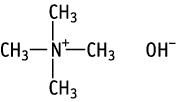

Tetramethylammonium hydroxide was studied for oral toxicity in rats in a 28-day repeat dose toxicity test at doses of 0, 5, 10 and 20 mg/kg. No deaths were observed in either sex. The animals repeatedly showed salivation after administration in the groups given 10 mg/kg and more. In the male animals, heart weight was decreased dose-dependently, and in the groups given 5 mg/kg and more the absolute heart weights were significantly less than the control group value. Thus, the NOELs for the 28-day repeat dose oral toxicity test of tetramethylammonium hydroxide are considered to be less than 5 mg/kg/day for males and 5 mg/kg/day for females.
Reverse mutation assays using microorganisms (Salmonella typhimurium, Escherichia coli) were conducted to assess the potential of tetramethylammonium hydroxide to induce gene mutations. Tetramethylammonium hydroxide did not induce gene mutations in bacteria under the conditions of this study.
In vitro chromosomal aberration tests using cultured cells (CHL/IU) were conducted to assess the potential of tetramethylammonium hydroxide to induce chromosomal aberrations. Tetramethylammonium hydroxide did not induce chromosomal aberrations in cultured cells under the conditions of this study.
| Purity | : | 20.19 %(water solution) |
| Test species/strain | : | Rat/Crj:CD(SD)IGS |
| Test method | : | OECD Test Guideline 401 |
| Route | : | Oral(gavage) |
| Doses | : | Males, 10, 15, 23, 34, 50 mg/kg Females, 23 mg/kg |
| Number of animals/group | : | Males, 5; females, 5 |
| Vehicle | : | Water for injection |
| GLP | : | Yes |
Test results:
The LD50 value was concluded to be between 34 to 50 mg/kg for males.
| Purity | : | 20.19 %(water solution) |
| Test species/strain | : | Rat/Crj:CD(SD)IGS |
| Test method | : | Guideline for 28-Day Repeated Dose Toxicity Test in Mammalian Species (Chemical Substances Control Law of Japan) |
| Route | : | Oral(gavage) |
| Doses | : | 0(vehicle), 5, 10, 20 mg/kg/day |
| Number of animals/group | : | Males, 10; females, 10(0, 20 mg/kg) Males, 5; females, 5(5, 10 mg/kg) |
| Vehicle | : | Water for injection |
| Administration period | : | Males and females, 28 days |
| Terminal kill | : | Males and females, on days 29 and 43 |
| GLP | : | Yes |
Test results:
Thus, the NOELs for the 28-day repeat dose toxicity are considered to be less than 5 mg/kg/day for males and 5 mg/kg/day for females.
| Purity | : | 20.0 % |
| Test species/strains | : | Salmonella typhimurium TA100, TA1535, TA98, TA1537, Escherichia coli WP2 uvrA |
| Test method | : | Guidelines for Screening Mutagenicity Testing of Chemicals(Chemical Substance Control Law of Japan) and OECD Test Guideline 471 |
| Procedures | : | Pre-incubation method |
| Solvent | : | Water for injection |
| Positive controls | : | -S9 mix; 2-(2-Furyl)-3-(5-nitro-2-furyl)acrylamide (TA100, TA98 and WP2 uvrA), Sodium azide (TA1535) and
9-Aminoacridine hydrochloride (TA1537) +S9 mix; 2-Aminoanthracene (all strains) |
| Doses | : | -S9 mix; 39.1, 78.1, 156, 313, 625, 1250 μg/plate(all strains) +S9 mix; 39.1, 78.1, 156, 313, 625, 1250 μg/plate(TA100, TA1535, TA98 and TA1537) +S9 mix; 156, 313, 625, 1250, 2500, 5000 μg/plate(WP2 uvrA) |
| S9 | : | Rat liver, induced with phenobarbital and 5,6-benzoflavone |
| Plates/test | : | 3 |
| Number of replicates | : | 2 |
| GLP | : | Yes |
Test results:
Genetic effects:
Salmonella typhimurium TA100, TA1535, TA98, TA1537
| + | ? | - | |
| Without metabolic activation: | [ ] | [ ] | [*] |
| With metabolic activation: | [ ] | [ ] | [*] |
Escherichia coli WP2 uvrA
| + | ? | - | |
| Without metabolic activation: | [ ] | [ ] | [*] |
| With metabolic activation: | [ ] | [ ] | [*] |
| Purity | : | 20.0 % |
| Type of cell used | : | Chinese hamster lung (CHL/IU) cells |
| Test method | : | Guidelines for Screening Mutagenicity Testing of Chemicals (Chemical Substances Control Law of Japan) and OECD Test Guideline 473 |
| Solvent | : | Water for injection |
| Positive controls | : | -S9 mix; Mitomycin C +S9 mix; Cyclophosphamide |
| Doses | : | -S9 mix(short-term treatment); 0, 228, 455, 910 μg/mL +S9 mix(short-term treatment); 0, 228, 455, 910 μg/mL -S9 mix(continuous treatment 24 hr); 0, 228, 455, 910 μg/mL |
| S9 | : | Rat liver, induced with phenobarbital and 5,6-benzoflavone |
| Plates/test | : | 2 |
| GLP | : | Yes |
Test results:
Genetic effects:
| clastogenicity | polyploidy | |||||
| + | ? | - | + | ? | - | |
| Without metabolic activation: | [ ] | [ ] | [*] | [ ] | [ ] | [*] |
| With metabolic activation: | [ ] | [ ] | [*] | [ ] | [ ] | [*] |
| 1) | The tests were performed by the Hatano Research Institute, Food and Drug Safety Center, 729-5 Ochiai, Hadano-shi, Kanagawa, 257-8523, Japan. Tel +81-463-82-4751 Fax +81-463-82-9627 |
| 2) | The tests were performed by the Biosafety Research Center, Foods, Drugs and Pesticides (An-pyo Center), 582-2 Shioshinden, Fukude-cho, Iwata-gun, Shizuoka, 437-1213, Japan. Tel +81-538-58-1266 Fax +81-538-58-1393 |